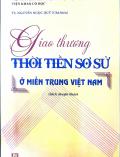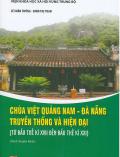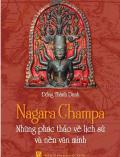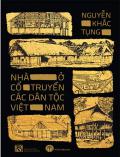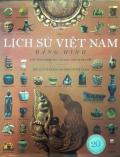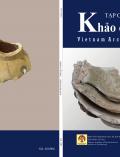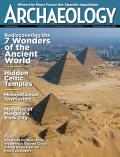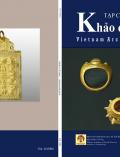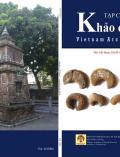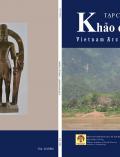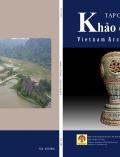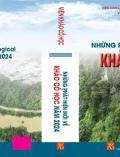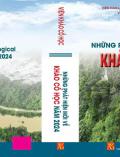|
No
|
|
Page
|
|
1
|
New data of stratigraphy and settlement patterns at Sủa Cán Tỷ prehistoric site (Hà Giang province)
NGUYỄN TRƯỜNG ĐÔNG
“The Sủa Cán Tỷ site, located at Cán Tỷ hamlet, Cán Tỷ commune, Quản Bạ district, Hà Giang province, was found in 2000 and excavated in 2013. It included 3 excavated trenches in 100m2 area. Its stratum consists of two separated layers: the upper deposited layer and the power clay layer. The artifacts lied completely in the deposited layer, which probably mean they had fallen down from the mountain cliff some time. The found artifacts include nearly 200 items, all of which are chopped pebbles mainly of Sơn Vi style, flakes, and a small number of Hòa Bình-styled tools.
This is a cultural remain of the late Neolithic inhabitants with the mobile living model to exploit food source”.
|
3
|
|
2
|
Ancient human bones at Diêm cave (Thanh Hóa province)
TRƯƠNG HỮU NGHĨA, NGUYỄN ANH TUẤN
“Diêm Cave, located at Sánh village, Thành Yên commune, Thạch Thành district, Thanh Hóa province was found in 2012 and excavated in the group of Vietnamese – Russian cooperation. The stratum of the excavated trench was 1.8m thick, including three cultural layers, which of which consisted of a burial. The two burials from the upper and the middle cultural layers belonged to 5 individuals whose remained bones were badly broken; some were burnt, they might have been secondary burials.
The human bones from the earliest cultural layer remain fairly intact. The positions of the skeletons remain in the surgical postures, which demonstrate that the deceased had been buried in the posture of the flexed leg. The anthropological components have been preliminarily identified with Mongoloidfactors but containing Australoid or Melanesian factors. This is one of a few burial sites of rare style from the ending stage of the late Pleistocene in Việt Nam”.
|
11
|
|
3
|
Huổi Han site (Lai Châu province) – Data and perception
LÊ HẢI ĐĂNG
“The Huổi Han site (Mường Tè town, Mường Tè district, Lai Châu province) was found in 2012 and excavated in 2014. The site stratum was over 1m thick, in which the cultural layer was fairly intact, about 55cm - 65cm thick. The relics found in the excavated trenches include fireplaces and places for stone making. The found artifacts consist of stone tools, mainly including chopped tools, flakes, pestles, choppers, a wholly-polished axe, a pre-formed bracelet and some grinding stones. The estimated date of the site is c. 4,500 BP – 4,000 BP, belonging to the Neolithic – early Metal Age. This site’s characteristics are similar to those of the system of site distribution in the area with the reservation of chopping tradition in the late Neolithic context in the northwestern part of Northern Viet Nam”.
|
22
|
|
4
|
Classification and dating of bronze drums from Khánh Hòa province
NGUYỄN PHÚC CẦN
“The collection of bronze drums found from Khánh Hòa province consists of 5 fairly intact drums that are possible to be studied. From the forms, decorative designs, accompanied objects and the classification of the bronze drums by the previous researchers, the authors have classified the drums from Khánh Hòa into some following groups, types and dates:
- The group A1 (Heger I) includes Đông Sơn-culture drums, with 3 items: Đại Cát I, Đại Cát II and Đại Mỹ drums, dated from the sixth century to the third century BC.
- The group B2 includes 2 drums: Nha Trang I and Nha Trang II drums, dated from the fourth century BC to the first century AD”.
|
30
|
|
5
|
Maritime archaeology in Quảng Nam and Quảng Ngãi
BÙI VĂN LIÊM, BÙI VĂN HIẾU
“Potentiality of underwater archaeology in particular and maritime archaeology in Quảng Nam and Quảng Ngãi is extremely great. The system of rivers, canals and arroyos in these two provinces is fairly dense; along the sea coast, there are many seaports and bays, which are favorable for ships and boats to travel and they also lie in the trade route on sea in the regions with famous seaports in the history. They include enough main types of relics and research objects for maritime archaeology such as ancient trade ports, sunken ships, and workshops for making ships and boats and the communities of fishers with their development history through thousands of years.
However, the maritime archaeology in this area has not developed as well as its potentiality and it is even facing the dangers of vandalism. Therefore, the systematic research into underwater or flooded sites and the relationships between them and the inland sites in these areas in the larger space and time is a vital task to set up a base for possible plans of protection, conservation and valorization of their values”.
|
37
|
|
6
|
Research on the stele of Đào Hoàng shrine (Thanh Hoài commune, Thuận Thành district, Bắc Ninh province)
PHẠM LÊ HUY
“At the Đào Hoàng shrine (Thanh Hoài commune, Thuận Thành district, Bắc Ninh province today), there is an ancient stele that has been found and studied since 2013. It has been dated to Kiến Hưng 2 preriod (314). In Nguyên Gia the twenty-seventh (450), when Đào Trân Chi, the descendent of Đào Hoàng, had the shrine built, following the order of the Giao Châu Jiaozhou governor Tiêu Cảnh Hiến, who had inscribed the second epigraphical characters at its back.
From the study on these second epigraphical characters and the comparison with the historical data, the author has edited the stele content, from which he has clarified some human characters, locations and historical events in Việt Nam during the fourth century to the fifth century.
The epigraphical characters on the Đào Hoàng shrine are invaluable historical source. This source suggests a possibility that the ancient Lũng Khê citadel was itself the Long Biên citadel built by the governor Đào Hoàng at the end of the third century”.
|
48
|
|
7
|
About some systems of water drainage at 18 Hoàng Diệu, the centre of Thăng Long Imperial Citadel
NGUYỄN HỒNG KIÊN, NGUYỄN VĂN MẠNH
“The paper refers to the system of water drainage from pre-Thăng Long and the Lý periods found at 18 Hoàng Diệu Street, the centre of the Thăng Long Imperial citadel.
Therefrom, the authors suppose that the traces of the drainage system around the construction enable us to identify the plan scales of its sites. The systems, "water flows" all mainly served as water drainage, whereas the defensive function, if there was, was just militarily secondary as these systems were all found in the forbidden Citadel, the military defense was not much significant.
In fact, we can see that the area of the Thăng Long Imperial citadel is low, not completely deposited. Therefore, without a good drainage system, people could not live there. The ancient architects/builders were "adaptable to the nature" in their thinking when they were based on the systems of rivers/ponds to build their systems of sewers and water drainage”.
|
60
|
|
8
|
Pillar bases of Trần period on the basis of archaeological data
BÙI VĂN HIẾU
“Under the technical angle, the traditional Vietnamese architecture includes constructions with wooden supporting frames that were mainly supporting pillars.
From the research on the traces of pillar bases from the Trần period, we can see that the rectangular architectural plans are most popular for the architectural constructions in the Trần period.
Similar to the Lý-period pillar bases, in the materials of the Trần’s ones, there are clay, bricks, tiles, gravels, stoneware and sagas. In addition, gravels were more popularly used and blocks of rocks were started to be used for building pillar bases.
Some basic techniques for building architectural bases also existed in the Trần period such as loading-ramming and arranging techniques. In terms of pillar-base type, the material layers were basically rammed to form but not as tightly and standardized as those of the Lý period”.
|
71
|
|
9
|
Archaeological values of western Yên Tử sites and some orientations of preservation, endorsement, and valorization
NGUYỄN VĂN ĐÁP
“The system of the pagoda sites from the Lý - Trần period in the western Yên Tử area in the locations of the Lục Nam and Lục Ngạn districts, Bắc Giang province includes: the Hồ Bấc, Cao, Đám Trì, Am Vãi, Hòn Tháp, Bình Long, Khám Lạng, Đồng Vành pagodas, etc.
The resent archaeological investigations and excavations at these pagodas provide more information for the research and restoration of the historical and cultural values related to Buddhism and the Trần-period Zen school of Trúc Lâm Yên Tử.
Based on the current statuses of these sites, the author proposes plans for preservation, endorsement and valorization of these sites”.
|
82
|
|
10
|
Changes of burial stupas from Lê Trung hưng period to Nguyễn period
MAI THÙY LINH
“Stupas are special architecture reflecting burial customs and serve as places for running sacrifices and worship by the eminent monks managing the pagodas. The research into these sites not only contributes to further understanding of their architecture but also provides important historical, cultural, religious and superstitious information.
The paper refers to the comparative research into the burial stupas of the Lê Trung Hưng period and those from the Lý - Trần period before it and the Nguyễn period after it. Therefrom, the author studies the changes in building materials, structure, decorative art on burial stupas as well as the social and religious backgrounds of the historical periods”.
|
93
|



